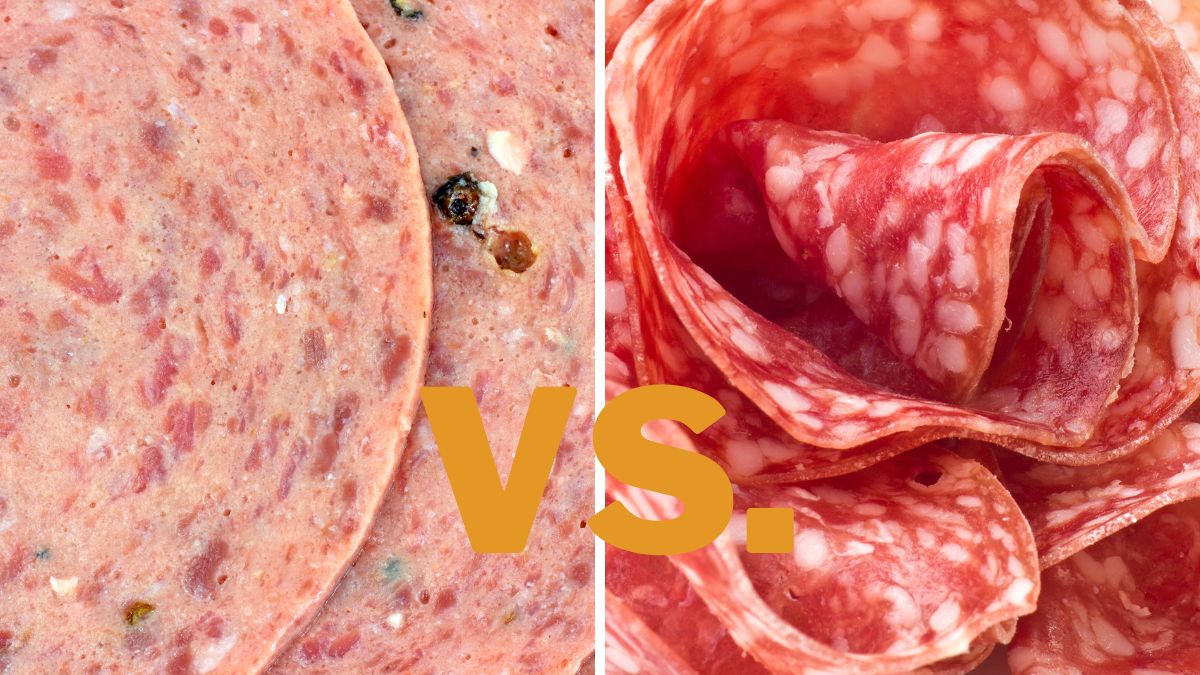Cotto Salami vs. Genoa Salami: Differences & Uses

The best sandwich, pizza, or charcuterie board always has some kind of salami included. This is why I always insist on including at least one kind of salami. Still, not all salami variants are the same — they differ in ingredients, preparation, and flavor. For example, do you know what’s the difference between cotto and Genoa salami?
Cotto salami is a cooked sausage that is smoked or boiled in water until the meat cooks. Meanwhile, Genoa salami is a cured and fermented sausage from Genoa, Italy. There’s no cooking involved; time and fermentation take care of the meat.
I find both of these salami types delicious and unique. So, I decided to look at them in detail. This article will help you determine which of the two is perfect for your needs. Let’s dig in!
Preparation Differences
The main difference between a Genoa and cotto salami is how they reach the end result.
They both start with some sort of meat — usually pork — along with salt, peppercorns, garlic, and wine. Depending on the sausage maker, a few other ingredients could be added to enhance the flavor.
All of the ingredients are mixed together before being stuffed into a sausage casing, but this is where the similarities end. How the sausage is handled differs from here, setting each type apart.
For Genoa salami, the sausage is left to dry and ferment on its own until it’s ready to eat. Naturally-occurring bacteria, salt, and the wine (if added) all work together to change the meat from inedible to something delicious. The result is a slightly greasy sausage with sharply-defined flavors.
Cotto salami, on the other hand, either gets smoked or cooked slowly with hot water. There’s no set rule on how to cook salami; as long as some heat touches the sausage, it’s considered “cooked.” Notably, “cotto” means “cooked” in Italian, hence the name.
Ingredients
There aren’t many ingredient differences between Genoa and cotto salami, but there are a few that set them apart.
For example, both kinds are made from pork, but Genoa salami uses medium-to-finely ground pork from better cuts. On the other hand, cotto salami can get away with using coarsely-chopped pork from cheaper cuts.
Their seasonings differ quite a bit as well. Cotto typically has intense flavors from seasonings such as fennel, garlic, and peppercorns, while Genoa lets the curing/fermenting process develop its complex flavors. You’ll likely find salt, garlic, and peppercorn on the ingredients list of a Genoa salami.
The most notable difference is the use of red wine in the process of making Genoa. It gets its acidic profile from red wine — an ingredient absent in its cooked counterpart. And since cotto salami is cooked, it relies more heavily on dry seasonings for its flavor instead of red wine.
Storage Differences
The way each salami is made also affects its storage requirements. Remember this to avoid losing your salami to the elements or, worse, you getting food poisoning!
Because Genoa salami developed its flavors by letting the bacteria do their thing, you can keep sliced or unsliced Genoa salami unrefrigerated. You don’t need to keep it airtight, either. The salami has already spent its life with ambient air the entire time, so it can survive a few more weeks until you can eat it all.
On the other hand, you must refrigerate cotto salami to prevent it from going rancid. Treat it as you would any cooked meat and keep it cool and dry in the fridge, only taking it out when you need a slice or two.
Best Uses for Cotto and Genoa Salami

Both sausages are versatile meats that can be used in various ways. Cotto salami is often sliced thinly and served as a cold cut, but I just love it as an excellent accompaniment for cooked dishes such as pasta, pizza, or even in grilled cheese sandwiches. It’s also a great salad topping for a burst of flavor!
Genoa salami is also commonly sliced and served as a cold cut (just like cotto salami), but it is also a popular inclusion in charcuterie boards, where it’s usually served paired with cheese. I suggest placing it on a piece of warm, crusty bread. And if you want an indulgent sandwich, why not put a few slices of Genoa between bread and cheese?
